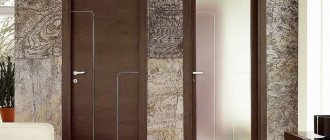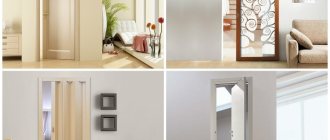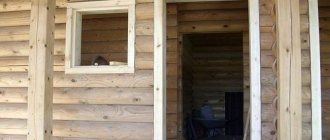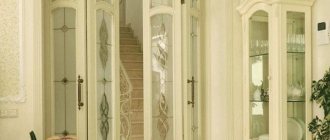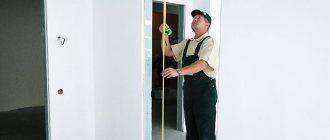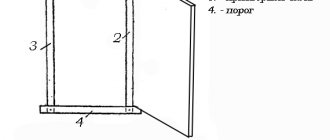In order to know the standard sizes of interior doors with frames, you need to study generally accepted standards. In addition, there is a special table with exact indicators. It is necessary when ordering, purchasing, and then installing the door leaf indoors. Each manufacturer has its own methodology for creating doors, but they are required to adhere to regulations. Below are the GOST standards on the basis of which standard doors are produced, tables with dimensions and possible markings.
Door size standards
GOST parameters must be taken into account not only when creating a door or frame, but also when calculating the opening. GOST standards related to interior doors:
- Opening to the kitchen - GOST 702007;
- For toilets and bathrooms - GOST 55-60190-2005-7;
- Bedroom – GOST 802007-20;
- Living room - GOST 2007-20.
The latter refers to double doors and an opening that must comply with the standard. Most often, when installation is carried out without the participation of a specialist, the standards prescribed in these documents are not taken into account. The construction market offers a lot of modern models of door leaves, but most often their size indicators have standard numbers: 200 cm, width 60-80 centimeters. The thickness of the box varies from 15 mm to 45 mm, but if you make an individual order at the factory or it is home-made, the thickness may vary.
If you do not comply with GOST standards for door sizes, this may lead to the need to expand the opening.
Doorway measurements
Correct measurements of the doorway allow you to select the most suitable door block in size. Three main parameters are measured: height, width and depth of the opening.
The height of the portal is measured in 3 places, for example, along the edges and in the center of the opening. The minimum indicator is taken as the main one.
In a similar way, the width of the opening is measured in three places; the smaller value is also taken as the main indicator. Most often, the narrowing of the wall occurs at the location where the interior door frame is installed. If the old door in the passage being measured has not yet been dismantled, it is recommended to measure the width of the opening from the central part of the platbands and take it as the standard.
The depth of the opening, also known as the thickness of the wall, is measured at the top, bottom and center of the opening to identify the thickest part of the partition. In an uninstalled door block, it is recommended to measure the width of the box beam and the remaining wall space.
If there are any doubts about the correctness of your own measurements, it is recommended to seek advice from the manufacturer of interior doors or a hardware store that specializes in selling doors. Typically, these organizations have specialists who will measure the opening within 20-30 minutes and tell you which door block and with what parameters are suitable in your case.
When choosing an interior door and its components, it is recommended not only to correctly measure the doorway, but also to familiarize yourself with domestic standards. Please note that a number of European door manufacturers (Finland, Italy, Spain) produce products adapted to Russian standards. French doors have slightly smaller dimensions compared to generally accepted standards. Therefore, it would be a good idea to measure the display sample of the door and frame using a tape measure before purchasing.
Common parameters
GOST standards state that the parameters of the box must correspond to the dimensions of the canvas, taking into account the gaps required for installation of the structure. If the manufacturer created the model correctly, the indicators will be as follows:
The proportionality of the frame and the thickness of the wall opening must be observed. If you purchased a canvas of a smaller size, it doesn’t matter, you can use such a device as an extension. It will tightly close the gap and hide the miscalculation.
The standard size of a door frame, which is prescribed in regulations, for a door to a room in height should be 190-200 cm. If the doorway is two meters, then the door itself is ordered several centimeters smaller. If this is not taken into account, then it will not be able to open and close freely.
The standard thickness of the canvas is 4.5 cm. The width, as a rule, depends on the dimensions of the room itself.
Double doors have their own characteristics. Wide openings can be present at the entrance to any room, but they are most often found in living rooms. GOST reports that the width of these canvases should vary from 120 to 150 cm. These parameters contain functionality and ease of use.
The largest sizes of door frames used by manufacturers in Russia for interior doors are 90 cm wide. As a rule, they are installed in industrial production, in offices or in large country houses. The opening should be proportional to the room itself. If the room is small, then a massive door leaf will look awkward or cumbersome. It is worth noting that in Soviet “Stalin” buildings this parameter was used, since the living area is very spacious. Such doors are produced in small quantities, and not very large enterprises make them exclusively to order.
Standard sizes of interior door frames
Their elements are made of pine boards or timber, and on top it is decorated with veneer of trees of more valuable species.
Box thickness
In standard apartments built in Soviet times, this size is 7.5 mm, so a box with a size of 10.8 cm is selected for them. If the thickness of the interior partitions is 10 cm, then you need to install a box of 12 cm. These are the standard sizes that are accepted domestic GOST standards. In interior doors from foreign manufacturers, the door thickness range is wider and ranges from 8 to 20.5 cm.
If the thickness of the wall turns out to be greater than the selected frame, then it can be increased by using additional elements or using a compensatory frame, which can be telescopic, expansion or act as a transformer.
To increase the strength of the door structure, it is recommended to use a magnetic seal for metal doors.
When taking measurements of interior doors, the thickness of the opening may be different; this is caused by the nature of the walls; they can be load-bearing or installed as partitions.
Height
It is regulated and can range from 190 to 200 cm. These dimensions will satisfy the opening dimensions ranging from 194 to 203 cm or 204-211 cm.
When calculating the height of the future door, you need to take into account the threshold. It can be from 1 to 2 cm, and in the end it can be 208 cm, and without it 206 cm. This is the ideal height that meets the standard dimensions of many door frames.
How to replace the seal for metal doors can be found at this link.
Door structure width
It is measured from one to the second wall. Between this distance the canvas and two side elements of the box should fit.
Read what locks for a metal entrance door are in this article.
The relationship between the doorway and the leaf.
The standard width is 800 mm. Almost all manufacturers adhere to this dimension.
If you need to insert glass into an interior door, this material will tell you.
Dimensions of extensions
Extras can be no less important than the box itself. Thanks to them, you can eliminate the hollow section of the doorway.
They come in two types:
- Planks with a protective edge. They are fixed in the opening with nails or an adhesive base. Their width can be changed by sawing, and their height is 2 meters.
- Telescopic extensions. Suitable for solving any lack of width. Their installation is carried out using a special lock, which is a “tenon and groove”. The groove is made in a box, and the tenon is on the extension. Their width is adjustable from the side of the platband.
The feasibility of using extensions can be determined after measuring the width of the doorway.
Read all the information about seals for interior doors here.
In the video, the dimensions of the extensions are:
Dimensions of double doors
Comfortable dimensions for use are door widths of 120-180 cm. If the opening does not allow them to be supported, then the door leaves will be different in width, one smaller leaf is fixed in its place, and the second with larger dimensions is used as a regular door. The latter has standard dimensions, and its smaller counterpart has dimensions equal to 1/3 of it.
The height of such doors can be from 2 to 2.5 m. The standard depth of double-leaf doors is from 7.5 to 11 cm.
Setting the parameters of doorways is not difficult if you know in which places they need to be measured. The obtained parameters are adjusted taking into account all gaps. If a mistake is made when installing doors in a house, it can be corrected by filing the frame or installing trim for interior doors ; with the front door, the situation is not so simple . If there is a large gap between them and the wall, it may be necessary to install a counter box.
You might be interested in learning more about platbands for wooden doors.
Marking
The dimensions of the door directly depend on the dimensions of the opening. The markings even for absolutely identical doors may vary, but all wooden door structures must comply with GOST 6629-88. It states that these parameters are used for the manufacture of interior doors for residential and public buildings. The type of product is marked with the letter “P”, which means panel, and the letter “D” indicates that the product is prefabricated. There is a difference in the type of cloth. If the abbreviation is “O”, it means the product is glazed, and if the letter is “U”, then the glass is made with continuous filling.
You can also find markings in the form of the letter “P”, which means that the product has a threshold, or “L”, telling the buyer that the door is left-handed.
Documents defining standards for doors and openings
Sizes for residential doors have historically been determined based on ergonomic factors. That is why they are not fundamentally different from the country of origin. In most countries, the documents defining them have not undergone changes for a long time. In the CIS countries, when producing doors, they still adhere to GOST, approved back in the USSR, with the number 6629-88. When designing construction work, in particular the installation of doors and openings, uniform SNiPs and similar European DINs in the range starting with 18100 are used.
Canvas and box sizes
According to SNiP, the standard size of an interior door with a frame is divided into several separate indicators, which are reflected in the table:
| Indicators of the door leaf, cm/width*height | Opening, cm/width and height |
| 60*200 | 68-71/205-207 |
| 70*200 | 78-81/205-207 |
| 80*200 | 88-91/205-207 |
| 90*200 | 98-101/205-207 |
| 60*190 | 68-71/195-197 |
| 55*190 | 63-66/195-197 |
| 60+60*200 | 128-131/205-207 |
If we talk about the European standard, the ratio will be as follows:
| Panel parameters, cm/width*height | Opening, cm/width and height |
| 60*200 | 70-74/206-208 |
| 70*200 | 80-84/206-208 |
| 80*200 | 90-94/206-208 |
| 90*200 | 100-104/206-208 |
| 60+60*200 | 134-140/206-208 |
The Russian width of the canvas for the kitchen will be 70 cm, for the toilet or bath - 60 cm, and for the room - 90 cm.
Typical dimensions of interior door frames
It is rational to buy a door in a complete set, which includes the door leaf with fittings, frame and trim.
In high-quality ready-made kits, the canvas and box match perfectly in size. There is a gap of 2–3 mm between the frame and the canvas at all points of the perimeter. Due to this, the sash moves unhindered, and the structure maintains good sound insulation.
As a rule, manufacturers indicate the dimensions of the interior door leaf - the dimensions with the frame will be approximately 3 cm larger around the entire perimeter, which must be taken into account when choosing. If the sash height is 2000 mm (Russian standard), then the height with the frame will be 2060 mm with a threshold and 2040 mm without a threshold.
The standard width of interior doors (according to the leaf) depends on the purpose of the room:
- living rooms – 800 mm;
- kitchen – 700 mm;
- bathroom – 600 mm.
These are the parameters for single-leaf doors (with one leaf). In apartments with two or more rooms, the opening to the living room can be wide. In this case, you will have to install a one-and-a-half or two-leaf model with two doors.
Measurement formulas
To take measurements yourself, it is not necessary to call a specialist for this. First you need to take into account such nuances as:
- Height;
- Width;
- Thickness;
- Platband parameters.
If the height of the canvas is 200 cm, the width is 70 cm, the frame is 3 cm thick, then the gap should be 1 cm, the door block should be 2 cm, and the height of the threshold should be 2 cm. To make calculations, these numbers must be substituted into the following formula: W dv +2*T k+Mz+2*Bd. The result will be: 70+2*3+1+2*2=81cm. If you need to find the height of a doorway with the same parameters, then the formula is as follows: B dv + B p + 2 * T, it turns out: 200 + 2 + 2 * 3 = 208. As a result, it turns out that a door with parameters of 200 by 70 requires a doorway measuring 208 by 81.
The standard opening depth is 7.5 cm, so manufacturers create door frames for this size. If the door has already been purchased, but it turns out to be smaller than required, you can find a way out of the situation - buy additional elements.
Selecting opening sizes based on standards
Guided by the standard, it is easy to select the size of the opening for the door you are purchasing. Domestic SNiPs prescribe fairly clear size ratios:
French manufacturers still use the English system of measures and their corresponding dimensions are approximately 1 cm smaller. Thus, a Russian door with a height of 200 cm corresponds to a French door with a height of 6 feet 6 inches or 198.1 cm.
A number of Italian boxes are thicker, and the ratio is determined by the DIN standard:
Algorithm for measuring the size of a doorway
The measurement process itself is no less important. Experts assure that it is precisely in this work that mistakes are most often made, and, accordingly, subsequent calculations will be incorrect. In order for the door frame in a residential or public space for interior doors to be measured correctly, and the dimensions to allow correct calculations to be made, the following sequence of actions must be followed:
- First, the height changes from the floor itself to the top of the opening. If you are sure that it is not level, measurements should be taken in the middle;
- The width is measured from the middle of the left to the middle of the right casing;
- The depth can only be known by taking comprehensive measurements: at the top, middle and bottom to find the widest value.
Standard table for calculating doorways:
| Width, cm | Height, cm | Type of room | Standard indicators |
| 62 — 65 | 195 — 197 | bathroom | 55*190 |
| 67 – 70 | 195 — 197 | Bathroom | 60*190 |
| 67 – 70 | 195 — 197 | Room | 60*190 |
If a person lives in an apartment or house with a standard layout, then the indicators of his measurements will be identical to those indicated in the table.
Priority between changing the size of the opening and choosing the door size
If a calculated discrepancy between the size of the opening and the desired type of door is identified, the owner has to make a choice: rebuild the opening or change his desire? To make a decision, you need to take into account that the width usually changes both upward and downward without problems. The height is determined by the already installed jumper. It does not imply its reduction. For any change in height, you will have to dismantle the ceilings above the top of the opening, place blocks or bricks and re-lay the lintel. Such work in some types of walls is extremely undesirable.
The comfort and even functionality of a home depends on the correct arrangement of door structures. And it starts with the correct calculations of doorways. Treat them responsibly. Discuss the results with experienced people or specialists, and the doors will answer you with their discreet and silent operation.
Video from Youtube on the topic of preparing a doorway for installing an iron door.
Related articles:
- Plasterboard partition with a door Plasterboard sheets are an ingenious building material that allows you to organize the redevelopment of a room in a short time and with minimal financial costs. Combining high […]
- How to lay linoleum: professional advice Changing the floor covering or laying a new one is one of the stages in improving the interior of your home. Most consumers today prefer to lay linoleum. IN […]
- Repairing the roof of a private house with your own hands Since the creation of the first structures by man, the roof has been the most important structural element of any house. With a wide variety of architectural solutions, it primarily […]
- How to glue vinyl wallpaper Vinyl wallpaper is very practical to use, and its affordable price will suit any family budget. That is why they are very often chosen for renovating an apartment or cottage. Peak […]
Box and gaps
When purchasing a door leaf, you need to pay attention to the dimensions of the interior doors, which are indicated on the packaging. There should be an explanation that the dimensions are written along with the box. As a rule, they should be increased by 10-15 cm when compared with the door dimensions. We must not forget that a gap should be left between the wall and the mounting panel, so the parameters of the panel should be less than the characteristics of the frame. Experts also recommend purchasing the structure along with cash, frame and fittings.
To make the box, manufacturers use bars, which can also vary in size. Average width: 1.5-4.0 cm, but the standard indicator: 3.0-3.5 cm. Only with the latest indicators can you count on the structure being strong enough and will last for many years. It is important to pay attention to the thickness of the box. It is best that it matches the parameters of the wall. For brick buildings it is 7.5 cm, and for wood it is 10 cm.
Types of boxes
There are different types of door frames based on design, material and other parameters. The boat, consisting of three or four elements, has the following methods of connecting the racks to the crossbar:
- Spiked. The door frame timber is joined using a tongue-and-groove lock. The method is complex, but reliable.
- Baguette. The edges of the timber are cut at an angle of 45º. The elements are connected using hardware.
- Right angle. Before joining at an angle of 90°, grooves are cut at the end of the beam, removing part of the quarter.
Of all the options, the design of a door frame with a right angle is considered simple.
The structure of the bows differs according to the type of fastening of the extensions and platbands :
- The simple one comes without grooves. Extensions and trims are fixed with glue, nails or self-tapping screws.
- The telescopic door frame is equipped with special grooves into which extensions and trims are attached.
- Monoblock. Innovative design. The box and platbands are one whole.
The advantage of the monoblock telescopic box is that it is fully equipped. You don’t have to buy additional trims and platbands separately.
According to the design of the boat, there are three types:
- Encompassing. The structure consists of a frame, extensions and platbands. The door frame is supplied with a seal. Cheap options may not have extras. The planks will have to be purchased separately.
- End The boat is designed for mounting on a special metal frame. Used when arranging openings for thin walls made of plasterboard.
- Corner. Ludka is considered universal. The frame with the platband is connected into a single structure. During installation, a seal must be installed.
Separately, it is worth considering the hidden door frame, which is completely hidden along with the hinges in the wall during installation. The entire block is made of aluminum and comes in two types:
- Ready box . The door has a laminated, enameled or other coating. Installation of mirrors is allowed.
- Boat for finishing . The canvas is covered with a layer of primer. After installing the block, it is subject to further finishing with wallpaper, painting or cladding with other materials.
The handles on the sash are also made hidden. Usually it is a slot on the canvas or a magnetic device.
Materials
The pots differ according to the material they are made of:
- The most common, inexpensive and durable are wooden door frames . During installation, products made from untreated timber are impregnated with an antiseptic and opened with varnish or paint. For a budget option, the boxes use solid pine . The technology of manufacturing from spliced timber allows you to get rid of wood defects. The frame elements are glued together from small blanks.
- Door frames of MDF, fiberboard and HDF . Frames are covered with laminate, veneer and other materials that protect the product from moisture and also make it attractive. Layered composites have excellent characteristics. The material alternates layers of wood waste with plastic.
- A special aluminum frame for a glass door comes with a seal and a set of corners. Ludka is installed in glass openings of offices and other organizations. Fixation occurs with pressure plates on the goujons.
Metal door blocks usually come with a seal, trim and fittings. The products are installed at the entrance to the building or individual offices of the organization.
Box installation
To save money, you can buy only the door leaf and install the frame yourself. The assembly process consists of the following operations:
- We lay the door leaf on a flat horizontal place and cover it with wooden blocks. We place a piece of cardboard at the ends, between the porches and the door, to create a gap. Then we align the ends of the beams and the top of the door.
- We apply the upper horizontal beam to the ends of the racks. We align it along one side, and measure the length of the bar along the edge of the other with a pencil. We saw off the excess with a jigsaw or hacksaw. And then on the inside we mark the pretend part.
Door frame device
- Next, we make cuts on the marked area using a hacksaw for metal, so that the cut is neat. We process the cut area with a chisel or hacksaw.
- After this, you can drill holes in the crossbar and screw it to the vertical post with self-tapping screws.
Attention! This technology for assembling the frame is suitable only for those doors whose ledges have a rectangular cross-section. For complex sections, the posts and crossbars must be sawn at 45°.
- Then we mark the location of the loops. Canopies must be installed at a distance of 20 cm from the top and 21 cm from the bottom. We attach the loops to the beam and trace them along the contour with a pencil.
- Using a milling machine or chisels, we make a platform for attaching hinges and a seat for the lower door hinge. We hang them on the racks using self-tapping screws.
- We measure the length of the opening and mark this distance on the racks; the excess needs to be sawed off.
- Now you can begin installing the structure in the opening. To do this, carefully lift the box from the floor and set it in place. If it does not fit into the hole, its position can be adjusted using wooden pegs.
Installed door frame
- Using a level or plumb line, we check the horizontality of the top beam, the perpendicularity of the racks and the verticality of the box itself. After this, it can be secured with dowels to the slopes.
- If the box is firmly seated in the opening, you can remove the temporary pegs and spacers and saw off the protruding parts of the wedges.
At this point, the installation of the door frame is ready. All that remains is to screw the hinges, hang the door leaf and install the trim. With a little carpentry experience and patience, you can save money on installation work, the main thing is to take all the measurements correctly and follow the instructions.
